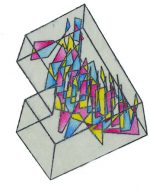I’m happy to announce that for the next 3 months, I will be teaching Designing Immersive Experience at Anant National University, working between Mumbai and Ahmedabad on a site-specific project focusing on a neighborhood in Mumbai called Mazgaon. Thank you, Vijay Sekhon and Irena Romendik, for considering me for such a fantastic opportunity. I genuinely look forward to learning as much as possible about this community and owning the honor to tell their story.
Here is the project description
Project Title: MAZGAON AND THE CITY OF ISLANDS CALLED MUMBAI
By Maia Marinelli
ANANT NATIONAL UNIVERSITY:
INTERACTION DESIGN DEPARTMENT
PROJECT FACULTY: MAIA MARINELLI, VIJAY SEKHON, WASEEM KADRI, SHARAT ACHARY
PROJECT DESCRIPTION:
Port cities and safe harbors are access points to a territory or a country. While oceans and waterways connect them to the rest of the world, they exist as a first line of contact between here and elsewhere, human and natural landscapes, and between the structured solid space and the unconstructed ever-changing liquid space.
Port cities function as a nesting ground where economic and cultural exchange takes place, giving life to eclectic societies capable of shaping an entire country’s economic and cultural profile. Yet, for this reason, port cities are sought after and battled over throughout history. In their womb and upon their seas, conflict brews, wars are fought, and power grabs unfold, scaring the lands with landmarks laced with trauma, colonialism, and cultural P.T.S.D.
This makes port cities complex yet resilient, rising, again and again, like a phoenix, rebuilding themselves, adapting and evolving with their surroundings, concealing their history through time in the layering of debre and architecture.
Once a port city loses its connection with its history, seafaring culture, and sea, it loses its identity and regenerative power.
Mazgaon, built on Machchgav island ( Kori’s for “reach of fish”), part of the Mumbai archipelago now known as the city of Mumbai, is no different. While part of an intricate historical tapestry, Mazgaon’s history has been largely ignored and possesses an identity of its own. A point of access in its own right and a piece of a grand er puzzle that collectively speaks to a reach cultural complexity such as Mumbai’s historical heritage, an archipelago of islands that became one of the largest cities in the world.
 |
 |
|---|---|
| The original seven islands of Mumbai | Mumbai today |
As artists and designers, our job will be to advocate for Mazgaon’s history, architecture, community, and natural surroundings through our work. As anthropologists or archeologists, we will observe “the site” and dig out history through data, artifacts, research, and human testimony. Our mission will be to reconstruct time and space, give voice to the untold and unseen, and create a non linear immersive experience capable of containing and protecting Mazgaon’s cultural heritage while interacting with its surroundings, evolving and seamlessly, and growing as it interacts with the city that is Mumbai today.
Using an anthropological and historical research approach, we will build a timeline identifying key historical events and landmarks to create a narrative blueprint to build upon. Upon this foundation, we will weave this timeline with “human experience” such as testimony, artifacts, letters, drawings, maps, prints, old photographs, and articles and collect video and audio interviews. The aim is to give data a personality, a voice through which Mazgaon’s story will be told, making the experience more personal and relatable.
Subsequently, we will process all contents through a collective, creative, and multidisciplinary process and identify the aesthetic, the looks and feels, the interaction design, and the narrative architecture of the work. We will use storyboards, collages, artificial intelligence, mind maps, nonlinear storytelling exercises, performances, sketches, drawings, illustrations, prototypes, audio, photo, and video editing. Here is where the character, the behavior, and the work’s identity will be shaped.
Finally, this “creative chaos” will be streamlined and organized into our final project, creating the perfect balance between usability, beauty, and content engagement.
This process will be fully documented and exhibited and the end of the class in Mumbai to open further dialog with the city. This exhibition will highlight all that has been discovered, the work done (both digital and non-digital), the roads taken, the approach followed, and the work done collaboratively with other artists and designers.
More importantly, however, this is the opportunity to work on the last step before the final production: user testing and research groups.
User testing is where the work and the interface are tested by allowing people of diverse backgrounds to interact with the project using a prototype.
While users interact with the interface and its content, the student will observe the behavior and ask the user questions about the content and the interface. Through this process, we will be able to determine what makes people excited about the experience and what does not, if the interface is engaging and intuitive to use and where it can be improved, if the content is engaging and well-presented if the users are discovering and learning something new about their city, what content resonate better with the community and most importantly how well represented the Mazgaon community feels and how well Mumbai community responds to the project.
The final immersive installation will be instilled in Mumbai on January 12th 2024.

